Montana is home to a diverse ecosystem, from the craggy peaks of the Rocky Mountains to the expansive Great Plains. In the following guide, we uncover the stories behind Montana’s 17 spotlight-stealing trees.
Are you a nature enthusiast, a botanist, or perhaps a traveler yearning to connect with local flora during your next Montana adventure? I, too, held this curiosity close to my heart and was rewarded by the incredible beauty these native trees offer. From the assertive Ponderosa Pines that form the backbone of many forested landscapes to the delicate Bitter Cherry, each tree has its unique charm, worth exploring in depth.
- Related article: Best Montana Nature Attractions
So, if you’re intrigued by the diverse natural tapestry that Montana holds, stay with me as we dive deeper into the hearts of these iconic native trees.
7 Key Takeaways on Types of Montana Trees
- Montana’s native trees, from the towering Ponderosa Pine to the sleek Rocky Mountain Juniper, form an essential part of the state’s landscape. These trees, often iconic for their resilience and variety, make Montana a haven for nature enthusiasts.
- Each tree, like the Ponderosa Pine with its towering height and children’s vote-in, or the Bitter Cherry with its shrub-like growth and red fruits, not only defines Montana but also contributes to its ecological web.
- Serviceberry’s modest size offers much more than just a pretty sight. From its beautiful spring blooms to its role as a wildlife habitat provider, the Serviceberry is a vital part of Montana’s ecology.
- Take a tour up Montana’s natural skyscrapers with the Douglas-fir, a tree with a 500-year fire cycle, or down to its flourished fields with the Rocky Mountain Juniper, a reddish-brown work of nature. These trees offer not just scenic beauty but valuable ecological roles and contributions.
- Trees like the economically significant Lodgepole Pine, valued for its timber and landscaping roles, or the majestic Western Larch, which thrives in Montana’s mountainous landscapes, underline the intricate relationship between nature and human industry.
- With native flora like the Bitter Cherry and the Lodgepole Pine, Montana showcases not only specific tree types but also an array of characteristics suited to the state’s diverse climates, from moist forests to dry and rocky terrains.
- Montana’s trees, from the ecologically important Ponderosa Pine to the commercially valuable Western Larch, offer a variety of options to suit both your environmental and personal needs in the state.
17 Most Iconic Native Trees in Montana
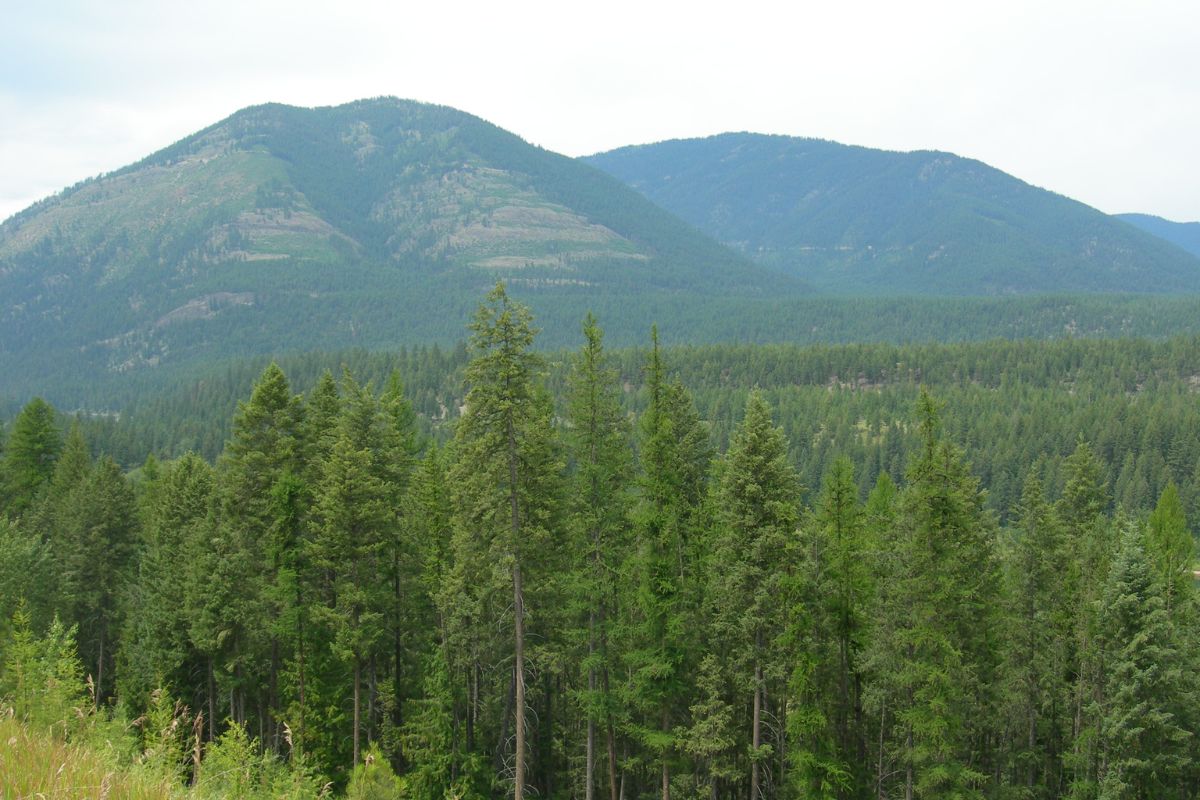
Montana’s symbiotic relationship with nature couldn’t be more evident than through its iconic trees. From the towering Ponderosa Pine to the striking Quaking Aspen, the state’s diverse landscapes are graced with these natural wonders.
Keep reading to learn about some of the most famous trees native to Montana, and discover where you can pay them a visit on your next nature walk or hiking expedition.
1. Ponderosa Pine (Pinus ponderosa)
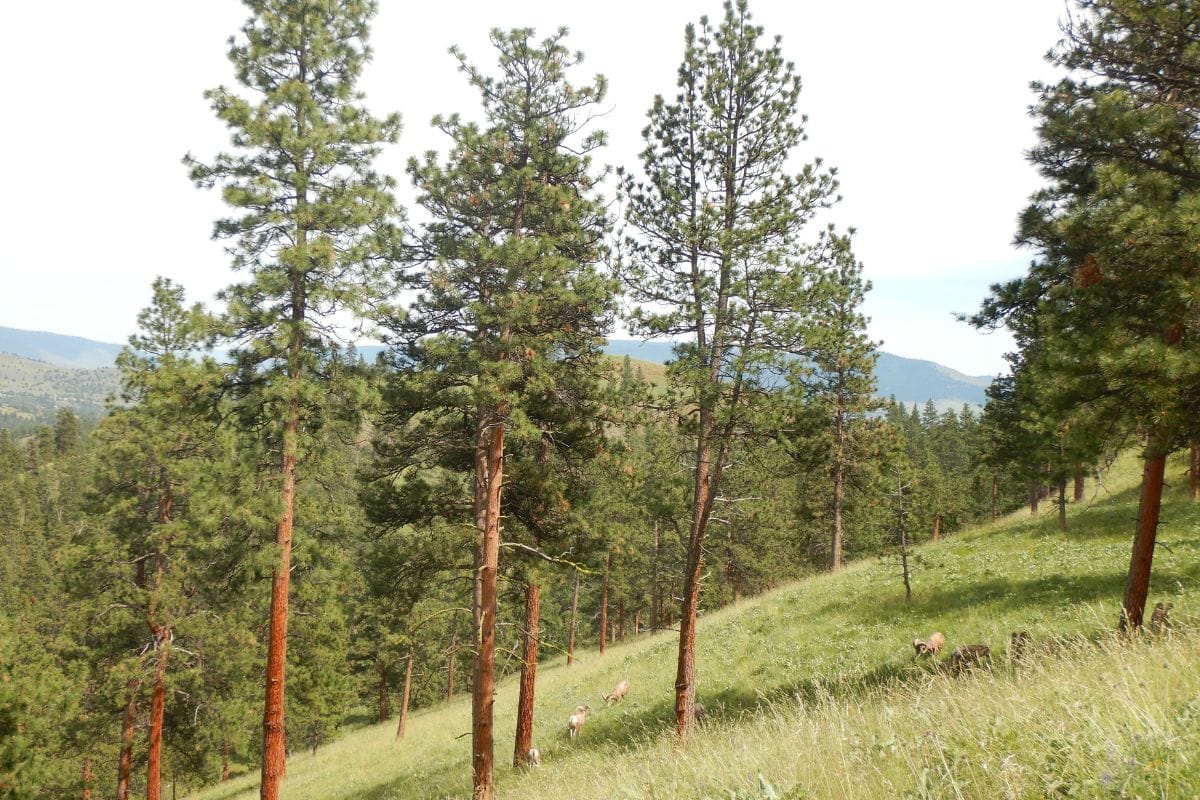
The Ponderosa Pine (Pinus ponderosa) holds a special place as the official state tree of Montana, a testament to its significance in the region. These majestic trees are renowned for their grandeur and resilience, defining much of Montana’s landscape.
Ponderosa Pines are characterized by their imposing size, with mature specimens often reaching heights of 100 feet or more. Their open, rounded crowns and spreading branches create a distinctive silhouette against the big sky of Montana.
One of their most notable features is their bark, which undergoes a remarkable transformation as the tree ages, transitioning from a dark, blackish hue in youth to a reddish-brown or orange coloration in maturity.
The tree thrives in warm and dry forest habitats, particularly in the southeastern part of the state. They are often found in areas where they can bask in full sunlight, favoring east- and north-facing aspects, and frequently bordered by mixed-grass prairie.
These trees are adapted to withstand the challenges of their environment, including low-intensity fires. Their thick bark and deep rooting habit enable them to resist such fires, ensuring their survival and the regeneration of the forest ecosystem.
Beyond their ecological significance, Ponderosa Pines hold cultural importance in Montana. Chosen as the official state tree in a 1908 poll by schoolchildren, they were officially designated as such in 1949.
The iconic status of these pine trees in Montana is undeniable, with their towering presence, distinctive bark, and vital role in the state’s ecosystem underscoring their significance to both nature and culture.
From providing habitat for wildlife to serving as a symbol of resilience and beauty, the Ponderosa Pine stands as a cherished emblem of Montana’s identity.
2. Bitter Cherry (Prunus emarginata)
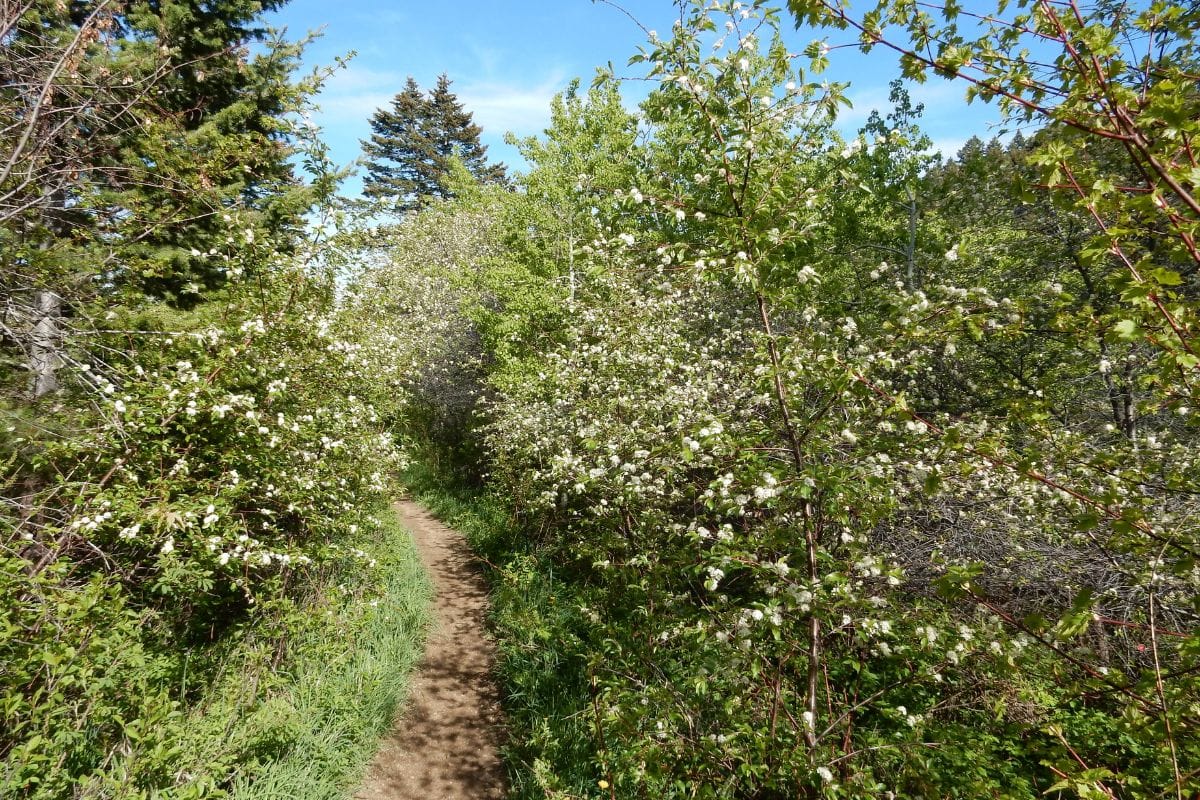
Bitter Cherry (Prunus emarginata) is a native tree to Montana, thriving in the diverse landscapes of the region. This deciduous tree, though sometimes appearing as a shrub, can reach heights of up to 5 meters (around 16 feet), adding to the rich tapestry of Montana’s native flora.
Preferred habitats for Bitter Cherry include moist, second-growth forests, streamside environments, and mountain brush, as well as riparian habitats. Its adaptability allows it to flourish in a variety of ecological niches.
The bark of Bitter Cherry is distinctive, typically sporting a reddish-brown or gray coloration. Horizontal lenticels dot the bark, facilitating gas exchange and adding to the tree’s visual appeal.
Leaves of the Bitter Cherry are characterized by their small size, oblong to oblanceolate shape, and rounded tips. Ranging from 2-8 cm in length, these leaves can be either smooth or slightly hairy beneath, known as glabrous or puberulent, respectively.
Come springtime, Bitter Cherry graces its surroundings with white or pinkish flowers arranged in flat-topped clusters. Following the blooms, the tree produces bright red fruits, approximately 1 cm in diameter, which are eagerly sought after by wildlife.
Ecologically, Bitter Cherry exhibits shade intolerance, favoring sparse woods, riparian sites, and open areas with signs of past disturbance. It plays a significant role as a member of seral brushfield communities in the Pacific Northwest and western Idaho, particularly following clearcutting, broadcast burning, and cattle grazing.
The attractiveness of Bitter Cherry extends beyond its ecological role, as it serves as a valuable resource for insects and wildlife. Its desirability makes it a popular choice for inclusion in woodland gardens, enriching both the landscape and the ecosystem it inhabits.
3. Serviceberry (Amelanchier alnifolia)

Serviceberry, a true Montanan at heart, graces our landscapes with its charming appearance and valuable contributions.
As a native tree to the Treasure State, it’s like a reliable friend who always shows up. Montana is predominantly part of the native region of Serviceberry, proving that what’s born here truly thrives here.
Growth Characteristics:
- Deciduous Nature – Reaching up to 5 meters (approx. 16 feet) but often spotted as a lovely shrub.
- Preferred Habits – Moist, second-growth forests, streamsides, and various mountain habitats. Imagine encountering it on your hike or as you float down a lazy river on a summer’s day.
- Characteristics in Focus – Smooth reddish bark that matures to a dignified gray, producing stunning white or pink flowers in spring followed by edible summer berries that our wildlife can’t resist.
- Leaf Appearance – Serviceberry leaves are simple, and oval, with a finely serrated edge. In autumn, they transform into a splendid symphony of yellow, orange, and red, livening up Montana’s fall palate.
Beyond mere aesthetics, Serviceberries are a hit as ornamental plants, create thriving wildlife habitats, and are being increasingly tapped for commercial fruit production.
Notable Serviceberry varieties include Saskatoon, Downy, Shadblow, Allegheny, and Juneberry, offering different shades and nuances to our local landscapes.
Popular among gardeners and landscapers due to its adaptability, it grows like a breeze in various conditions, making Montana’s patchwork of environments its home.
4. Lodgepole Pine (Pinus contorta)
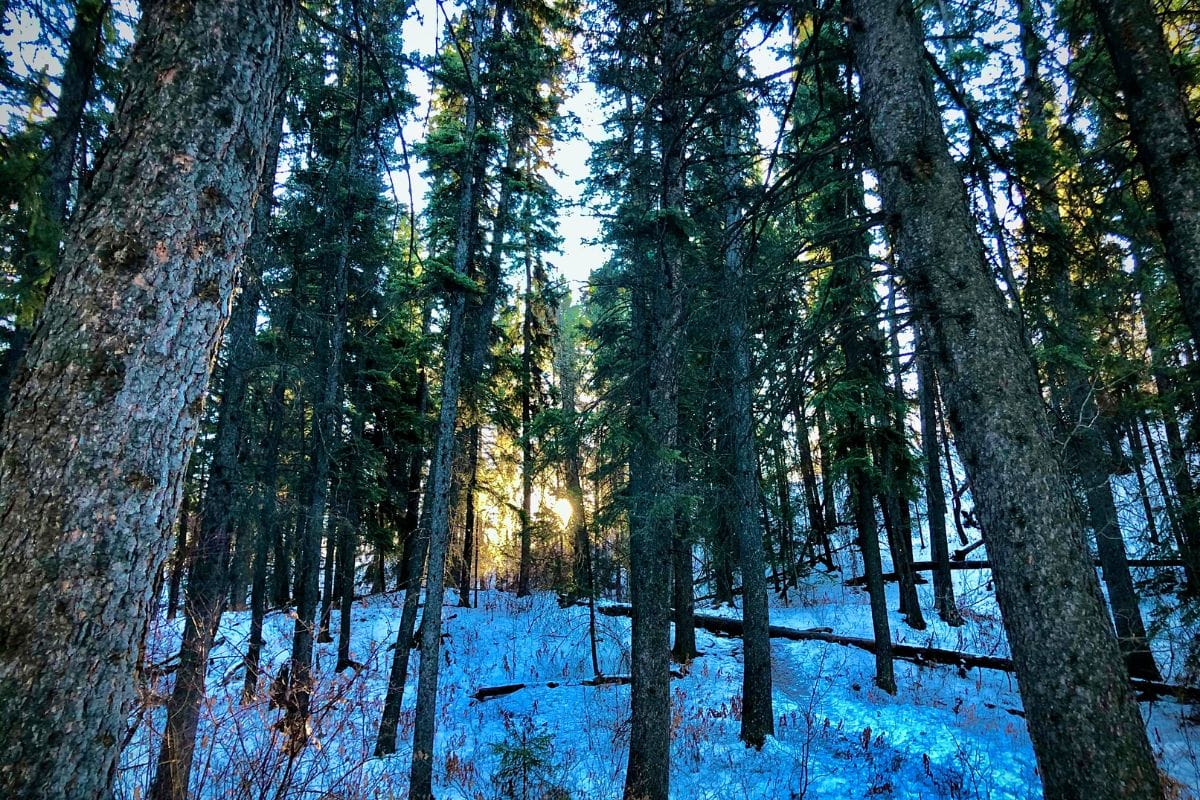
The Lodgepole Pine (Pinus contorta) is a tree species native to Montana, primarily found in the upper montane to lower subalpine forests throughout the state. These iconic trees contribute significantly to Montana’s diverse forest ecosystems.
Growing up to 35 meters (115 feet) tall, Lodgepole Pines boast a distinctive conical crown that sets them apart in the landscape. Their bark, thin and scaly, can range in color from brown to gray, adding to their rugged appearance.
Habitat-wise, Lodgepole Pine is versatile, thriving on flats, slopes of all degrees and aspects, as well as valley bottoms. They can be found at elevations ranging from 975 to 2,743 meters (3,200 to 9,000 feet), demonstrating adaptability across a wide range of environments.
As a seral species, Lodgepole Pine requires full sunlight for optimal growth and plays a crucial role in the re-establishment of forests following disturbances. In productive habitats, Lodgepole Pine stands may experience waves of mortality before reaching 120 years old, with the shrub stratum varying from conspicuous to absent.
Ecologically, Lodgepole Pine stands to undergo succession, often giving way to Douglas-fir forests at montane elevations east of the Continental Divide, further enriching Montana’s diverse forest landscapes.
Beyond its ecological significance, Lodgepole Pine also offers ornamental value, with its pyramidal growth habit, rich green evergreen foliage, and shaggy brick-red bark adding visual interest to landscapes.
As an aggressive colonizer and shade-intolerant conifer, Lodgepole Pine is commonly found throughout the Rocky Mountains and other regions of western North America.
Its adaptability and low maintenance requirements make it a popular choice for various landscape applications, including vertical accents, windbreaks, and shelterbelts, further cementing its status as a versatile and valued species in Montana and beyond.
5. Douglas-fir (Pseudotsuga menziesii)
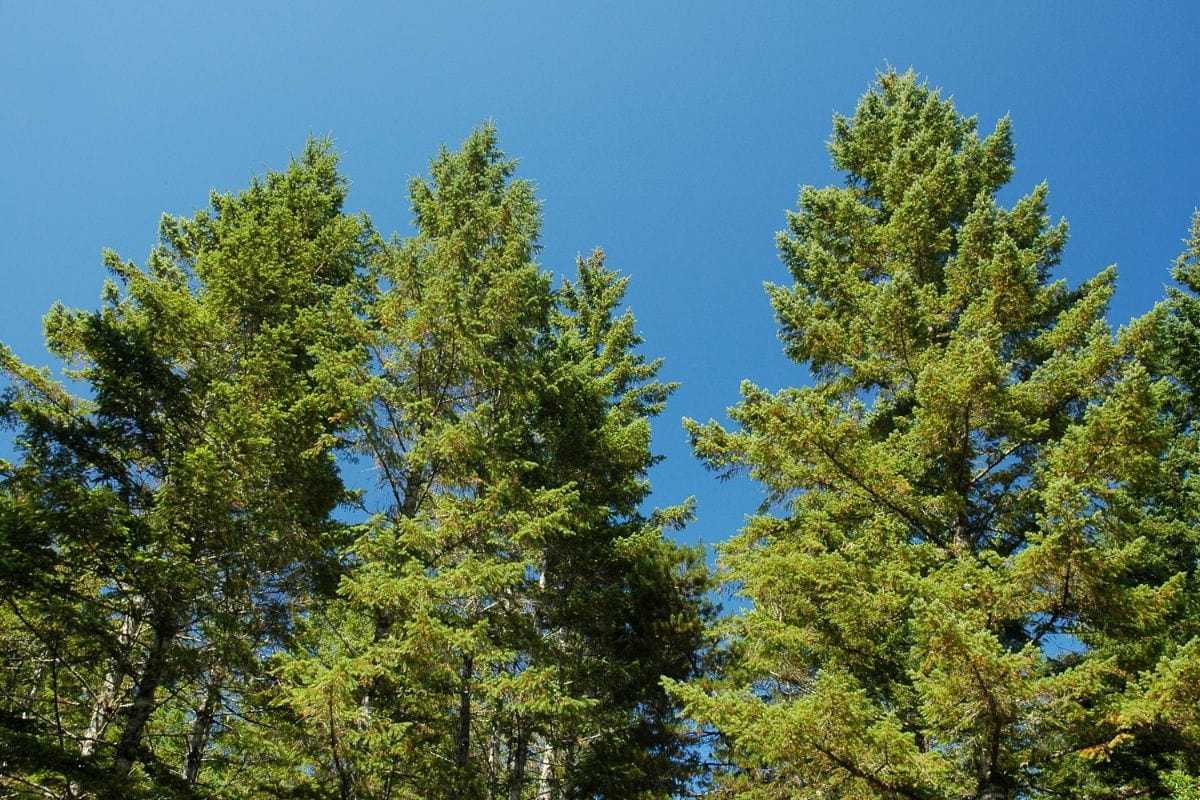
The Douglas-fir (Pseudotsuga menziesii) is a tree species native to Montana, primarily flourishing in the western part of the state, where it contributes significantly to the region’s forest ecosystems.
- Size – Capable of reaching heights up to 60 meters (197 feet), with spreading branches and narrow to broadly conical crowns.
- Bark – The bark of older trees is thick, furrowed, and typically gray, protecting against environmental stresses.
- Habitat Distribution – Found across western North America, with two varieties: coast Douglas fir along the Pacific Ocean and Rocky Mountain Douglas fir in the Rocky Mountains.
- Dominance – Douglas-fir often dominates as a species in regions like western Washington and Oregon.
- Understory Associations – Douglas-fir/pinegrass type is common in Montana, occurring on north-facing aspects in most areas and south-facing aspects at higher elevations.
- Fire Disturbance – Intervals between fires can be infrequent, sometimes up to 500 years, with trees able to attain ages of 500 to 1,500 years on certain sites.
- Regeneration – Demonstrates robust regeneration after fire disturbances, developing fire-resistant bark over time, promoting tolerance to low to moderate-intensity surface fires.
- Economic Value – Douglas-fir holds economic value as a timber species, used for lumber, pulp, and paper production.
The ecological importance of Douglas-fir extends beyond its commercial value, providing vital habitat for various wildlife species and playing a crucial role in maintaining the overall health and diversity of forest ecosystems in Montana and across its native range.
6. Western Larch (Larix occidentalis)
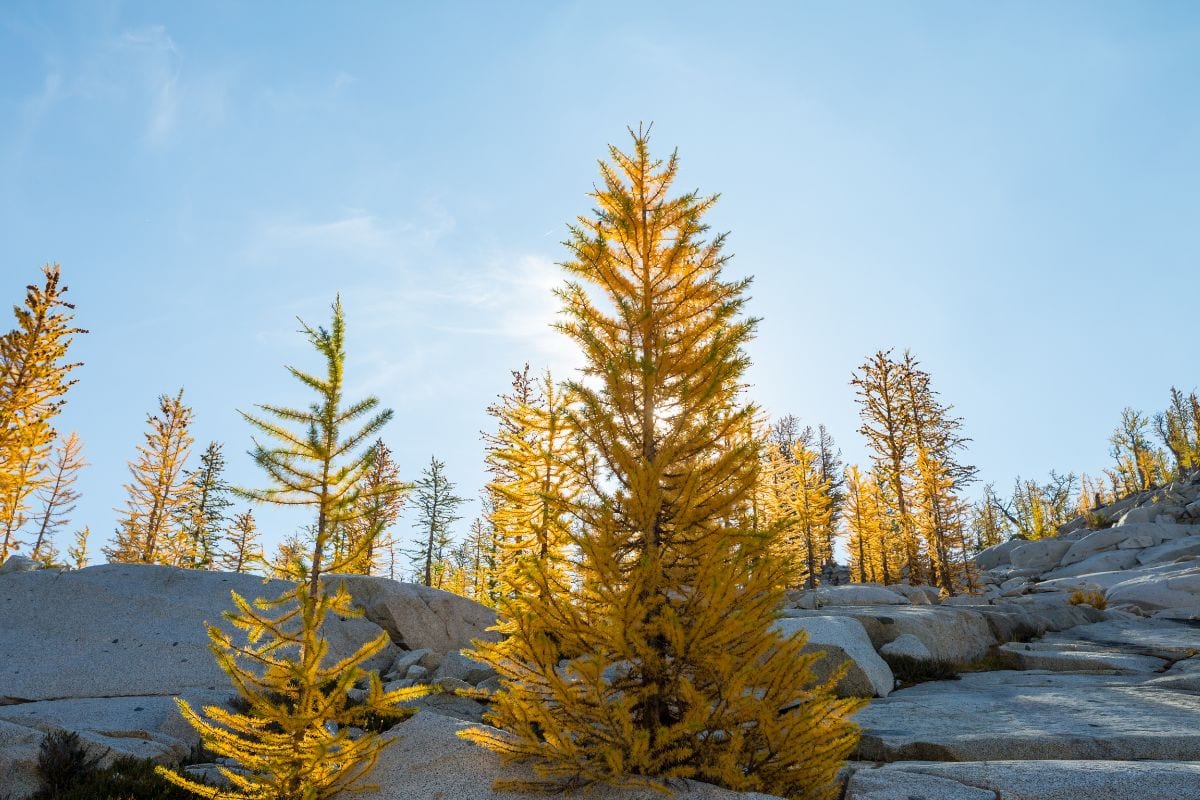
The Western Larch (Larix occidentalis) is native to the alpine and subalpine forests of the northwestern United States and western Canada, including Montana. This deciduous conifer is renowned for its impressive stature, reaching heights of up to 60 meters (197 feet) and boasting a narrow, conical crown.
Its bark, with a purplish-gray hue and deeply fissured texture, adds to its rugged allure. Thriving at elevations between 1,500 to 5,500 feet (460-1,700 meters), the Western Larch exhibits genetic variation influenced by latitude and elevation, particularly evident in Rocky Mountain populations.
Known for its vigor, the Western Larch is fast-growing and long-lived. Its bright green leaves, approximately 1.5 inches long, provide a vibrant canopy during the growing season. In summer, its cones adorn the landscape with a rich purple hue, accented by orange and yellow bracts that mature to a distinguished purple-brown.
Remarkably resilient, the Western Larch regenerates well after disturbances like fire, showing higher rates of regeneration following low-severity burns. This capacity not only ensures its survival but also shapes forest ecosystems.
Beyond its ecological role, the Western Larch holds economic significance as a timber species. Its wood, prized for its strength and durability, is utilized in industries such as lumber, poles, and posts, contributing to regional economies.
In essence, the Western Larch stands as a symbol of nature’s resilience and beauty, enriching the landscapes of the northwestern United States and western Canada, including Montana, with its towering presence and valuable contributions to both ecology and economy.
7. Rocky Mountain Juniper (Juniperus scopulorum)
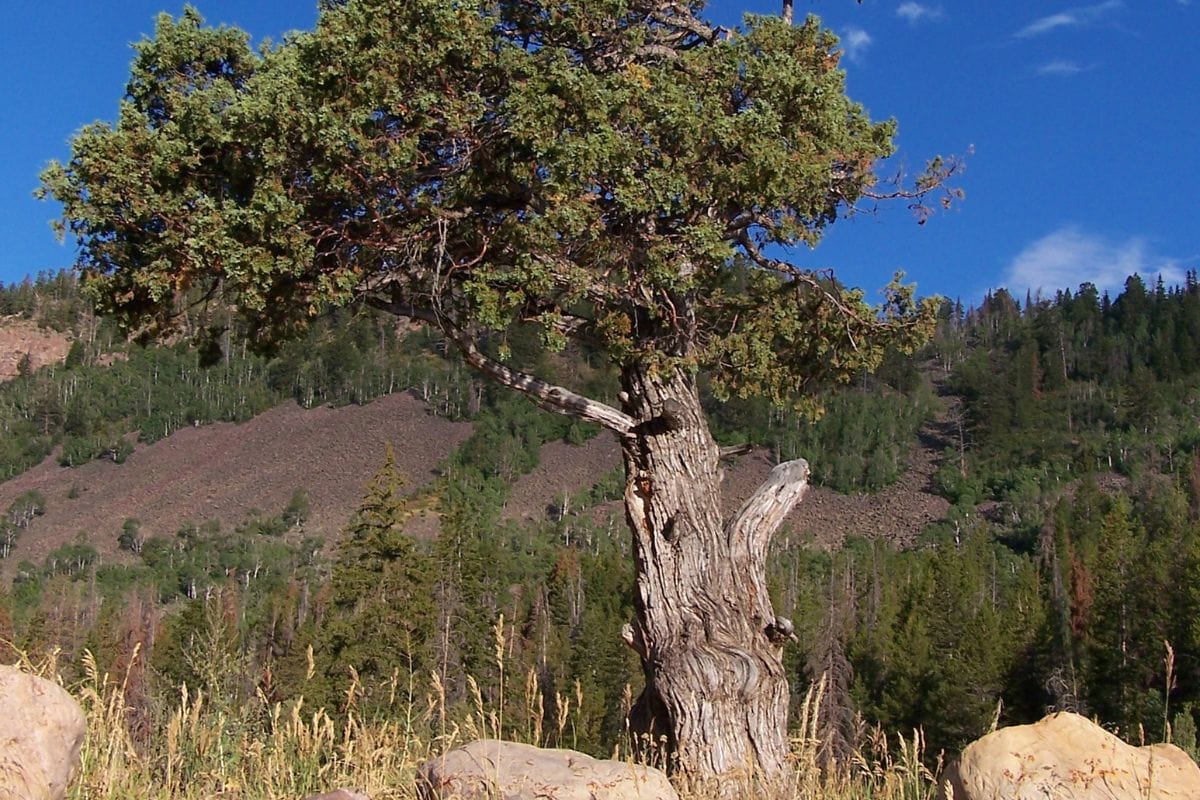
The Rocky Mountain Juniper (Juniperus scopulorum) stands proudly as a native tree species in Montana, commonly gracing various regions of the state with its presence. This hardy juniper species adds to the diverse tapestry of Montana’s natural landscapes.
In terms of size, the Rocky Mountain Juniper is a medium-sized tree, capable of reaching heights of 30-40 feet (around 9.1 to 12.2 meters) tall, with a trunk diameter ranging from 1-2 feet. Its stature lends a sense of rugged elegance to the environments it inhabits.
The bark of the Rocky Mountain Juniper is distinctive, characterized by its thin, shredding nature and reddish-brown coloration, adding to its rustic charm. This feature sets it apart in the Montana landscape.
When it comes to foliage, the Rocky Mountain Juniper displays two types of leaves. Young growth typically features sharp, spreading, needle-like leaves, while mature branches bear overlapping, scale-like leaves, contributing to its unique appearance.
Come the fruiting season, female Rocky Mountain Juniper trees produce small, round, bluish, berry-like cones containing one to three seeds, adding visual interest to the tree and providing a food source for wildlife.
Habitat-wise, the Rocky Mountain Juniper thrives in a variety of environmental conditions. It is commonly found in dry, rocky, or sandy soils, with a remarkable ability to adapt and grow in different habitats, from valley floors to mountain slopes.
The wood of the Rocky Mountain Juniper holds several practical uses, prized for its durability. It finds application in fence posts, as fuel, and in craftwork. Additionally, the tree serves an ecological role by providing cover and nesting sites for wildlife, further enhancing its value in the Montana landscape.
The Rocky Mountain Juniper holds significance in the Montana landscape, with its distinctive and rugged beauty adding to the state’s natural charm. Its contributions to the ecosystem, along with its practical uses, highlight its importance and enduring presence in Montana’s natural heritage.
8. Subalpine Fir (Abies lasiocarpa)
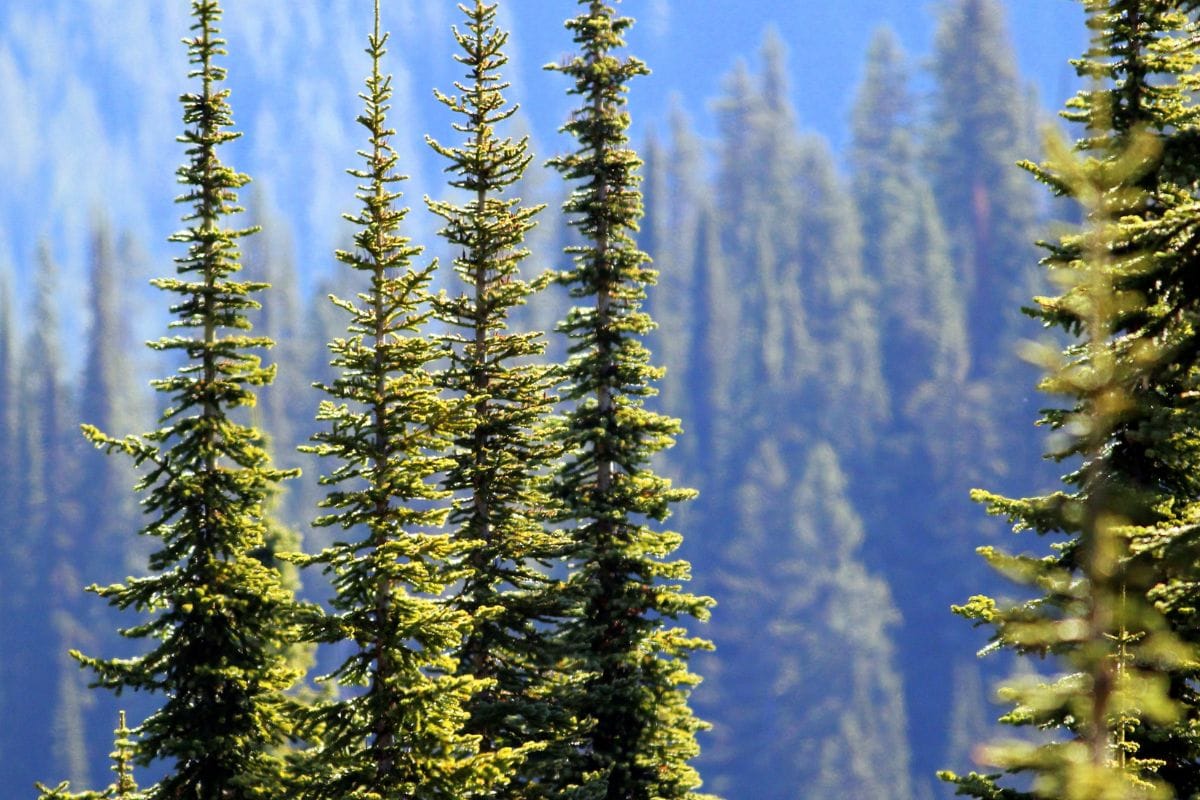
The Subalpine Fir (Abies lasiocarpa) stands as a native treasure within the rugged landscapes of Montana, particularly thriving in the subalpine forests nestled amidst the northwestern Rocky Mountains.
Despite being the smallest of the fir trees, its presence is significant, especially in areas ranging from 7,000 to 11,500 feet (approx. 2,133.6 to 3,505.2 meters) in elevation. Within these lofty heights, the Subalpine Fir finds its niche, often flourishing in mesic to wet forests west of the Continental Divide.
Distinctive in appearance, the Subalpine Fir showcases a slender spire shape and needles that uniformly curve, evoking a rustic charm in the high country. Adding to its allure are the dark purple cones it produces, which punctuate the landscape with a touch of color.
In certain areas, the Subalpine Fir forms pure stands, though its dominance may be rivaled by Engelmann spruce, a relationship that varies across different ecological contexts. Ecologically, the Subalpine Fir plays a vital role in the dynamics of the subalpine ecosystem.
Over time, particularly in the absence of fire or amidst spruce budworm attacks, it tends to largely supplant spruce within its habitat, except in the wettest sites. This succession underscores the Subalpine Fir’s resilience and adaptability in shaping and sustaining mountain ecosystems.
In Montana’s natural heritage, the Subalpine Fir is significant, enriching biodiversity and ecological resilience in the subalpine forests. Its presence showcases the intricate interplay between flora, fauna, and environment in the high country.
9. Limber Pine (Pinus flexilis)
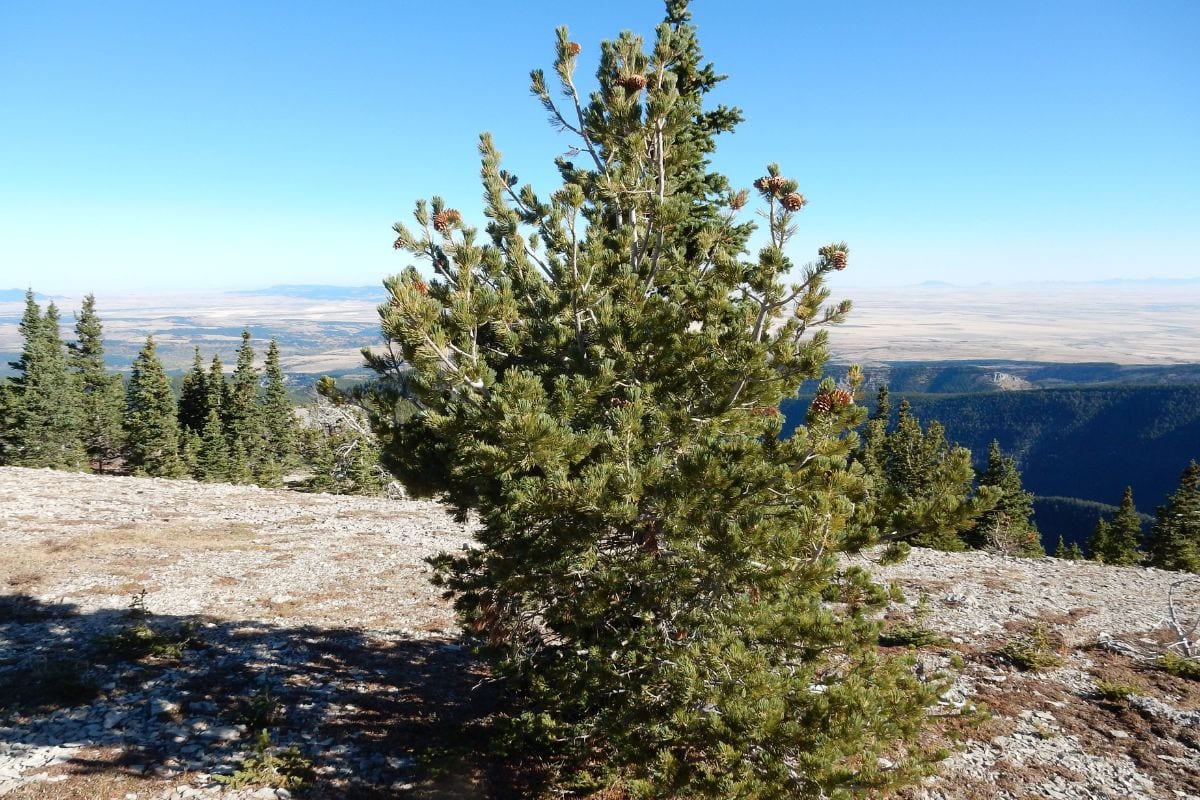
The Limber Pine (Pinus flexilis) stands proudly as a native tree species in Montana, thriving amidst the majestic peaks of the Rocky Mountains. Here are the things that you should know about:
- Native Status – The Limber Pine (Pinus flexilis) is a native tree species in Montana, commonly found in the Rocky Mountains.
- Size – This long-lived tree is slow-growing and typically reaches small to medium sizes. It thrives in areas ranging from 7,000 to 11,500 feet (approx. 2,133.6 to 3,505.2 meters) in elevation, adapting to the rugged conditions of its mountainous habitat.
- Habitat Preferences – Limber Pine shows remarkable adaptability, thriving in various environmental conditions. It is commonly found in dry, rocky, or sandy soils, from valley floors to mountain slopes.
- Characteristics – The Limber Pine earns its name from its pliant branches, which gracefully sway in the mountain breezes. Its specific epithet, flexilis, further highlights this characteristic.
- Cones – Producing dark purple cones, the Limber Pine adds a touch of mystery to its rugged appearance, contributing to its aesthetic appeal.
- Wood Uses – While Limber Pine wood is not as sought after as other species, it has its uses. Its lightweight, close-grained nature and pale yellow color make it suitable for rough construction, mine timbers, railroad ties, and poles. However, its harvest is often incidental to that of more desirable species.
The Limber Pine holds significant importance in the Montana landscape. Its distinctive and rugged beauty adds character to the environment, while its contributions to the ecosystem, including habitat provision and soil stabilization, further underscore its value.
10. Engelmann Spruce (Picea engelmannii)
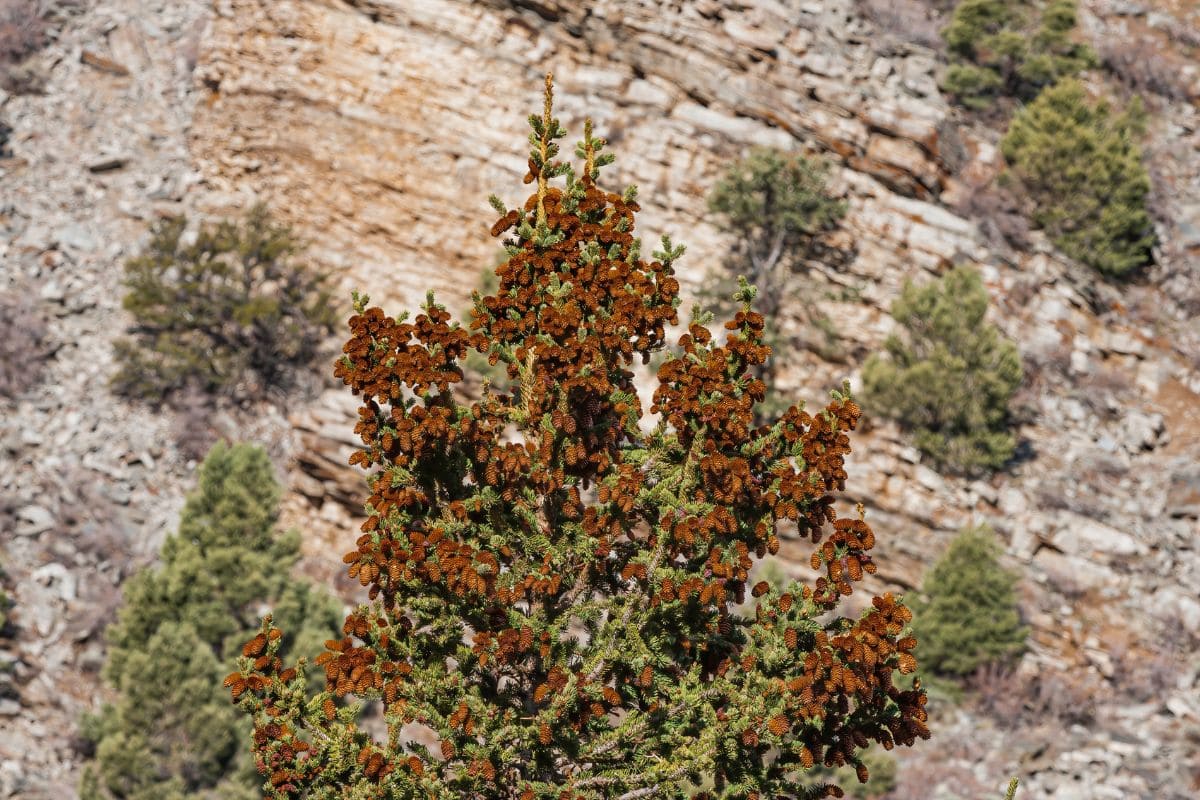
The Engelmann Spruce proudly holds its status as a native species in Montana, flourishing in the subalpine forests of the northwestern Rocky Mountains.
Towering over the landscape, these majestic trees typically reach impressive heights, thriving in elevations ranging from 7,000 to 11,500 feet (approx. 2,133.6 to 3,505.2 meters). Found predominantly in mesic to wet forests west of the Continental Divide, Engelmann Spruce exhibits a preference for cool, moisture-rich environments.
Characterized by its tall, straight trunk and narrow, spire-like crown, the Engelmann Spruce adds a sense of grandeur to Montana’s subalpine ecosystem. Serving as a cornerstone species, it plays a vital role in shaping the ecological dynamics of the region.
While in some areas, it may outlive its counterpart, the subalpine fir, over time, the dominance patterns often shift, with subalpine fir replacing spruce within most habitats of this system.
However, the influence of insects and disease cannot be overlooked in the intricate balance of these forests. Insect pests like the spruce budworm can significantly impact the health and composition of Engelmann Spruce and subalpine fir stands, altering their successional direction and species composition.
Despite these challenges, the Engelmann Spruce remains resilient, standing as a testament to the enduring beauty and ecological significance of Montana’s subalpine forests.
11. Grand Fir (Abies grandis)
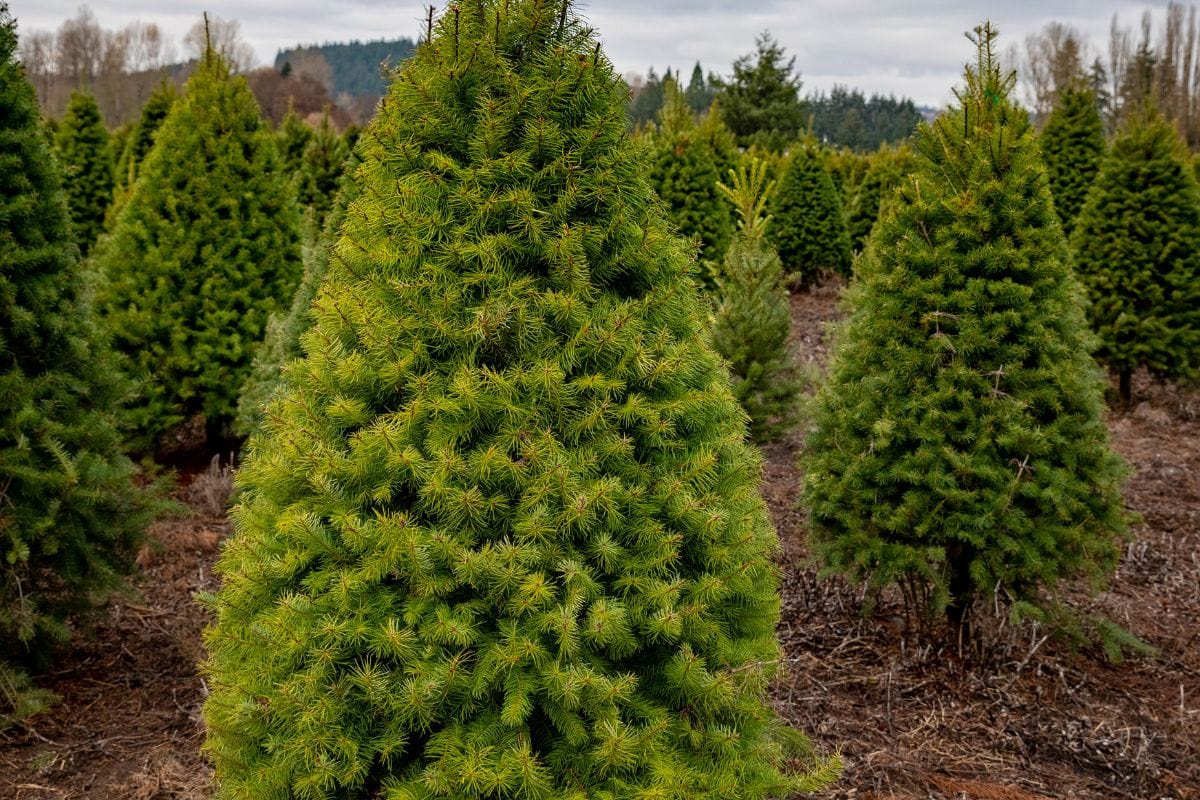
The Grand Fir, a native species found in Montana and various parts of the western United States, stands as a towering emblem of the region’s rich forested landscapes.
Renowned for its impressive size, the Grand Fir boasts specimens reaching heights exceeding 260 feet (80m), although it typically grows to a range of 135’ to 180’ (40-55m). Despite its stature, this species is relatively short-lived, often living less than 300 years.
Inhabiting the Rocky Mountains of Idaho and Montana, as well as regions in Washington, Oregon, and California, the Grand Fir thrives in diverse habitats, from lowland valleys to mountain slopes. Its distinctive features include long needles borne horizontally on opposite sides of the branch, lending the entire branch a flattened appearance with distinct upper and lower sides.
Grand Firs exhibit dynamic growth patterns, with rapid development in open environments but slower growth in shaded areas. While they are shade-tolerant, they may not withstand shade as well as some other species, making them more selective in their habitat preferences.
Valued for its versatility and utility, the Grand Fir holds significance as an important timber tree. Its wood finds application in various products, including lumber, plywood, and paper pulp, contributing to numerous industries and economies across the western United States.
As a cornerstone of the region’s forest ecosystems, the Grand Fir epitomizes the resilience and resourcefulness inherent in nature’s bounty.
12. White Spruce (Picea glauca)
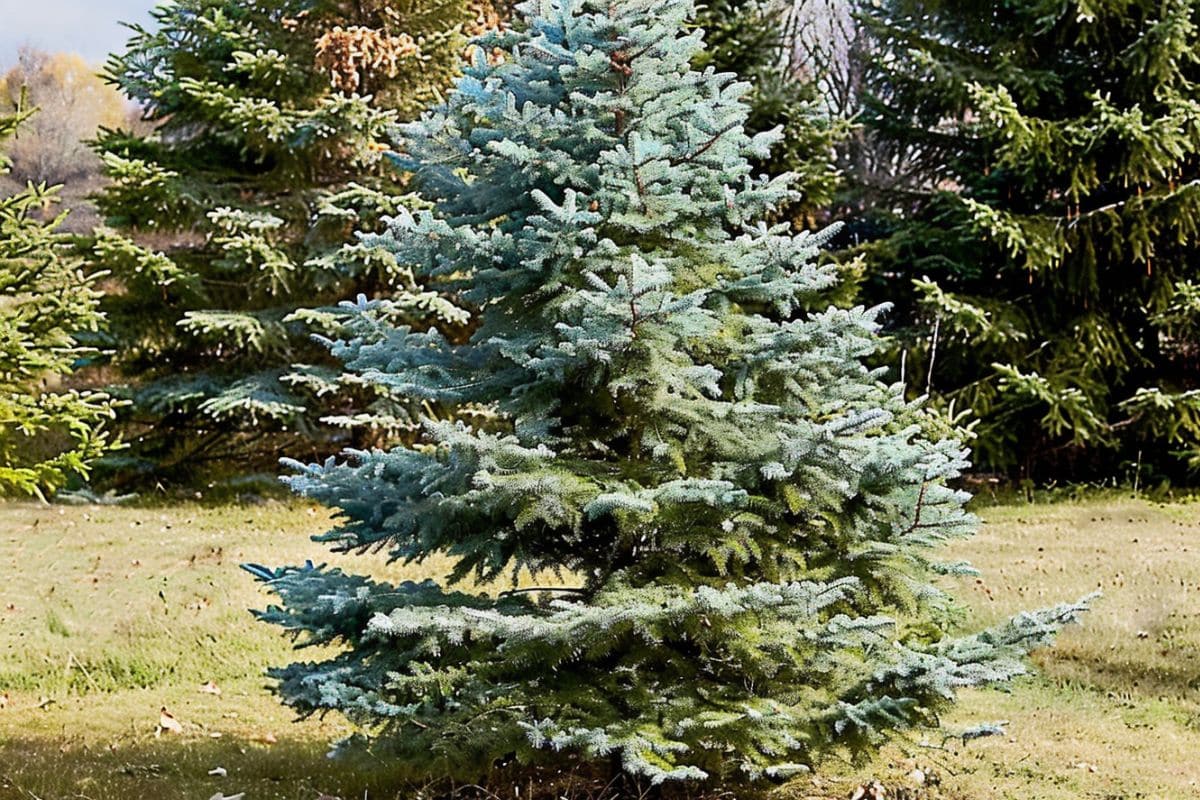
You might have already come across the White Spruce, often referred to as the ‘Montana Spruce.’ It’s a native species to Montana, typically gracing the more rugged, subalpine landscape of the state’s northwestern Rocky Mountains.
- Native Status – Despite its name, the White Spruce is a prominent member of Montana’s evergreen landscape, contributing its distinct bluish-green hue to the region’s natural beauty.
- Size – Towering above the forest floor, White Spruces command attention with their impressive heights of 60-100 feet (around 18.3 to 30.5 meters) and diameters ranging from 1 to 2 feet, standing out amidst their surroundings.
- Preferred Habitat – Thriving in mesic to wet conditions west of the Continental Divide, White Spruces find their niche in environments where moisture is abundant, making them a common sight for hikers exploring damp, forested regions.
- Identifying Features – Recognizable by their bluish-green, spiral-set needles, each measuring between 1/2 to 3/4 inches, White Spruces leave a distinctive mark on the landscape, offering a visual feast for keen observers.
- Cones and More – While their “light brown cones” may sound delicate, these 2-4 inch behemoths are robust structures, efficiently facilitating the propagation of future generations of White Spruces.
Beyond their aesthetic appeal, White Spruces play a vital role as a renewable resource superstar. From providing sturdy timber for lumber and plywood to fibers for paper pulp, they contribute to various industries.
Their seasonal role as cherished Christmas trees brings joy and nostalgia to countless homes across the state, further solidifying their place in Montana’s cultural heritage.
13. Paper Birch (Betula papyrifera)
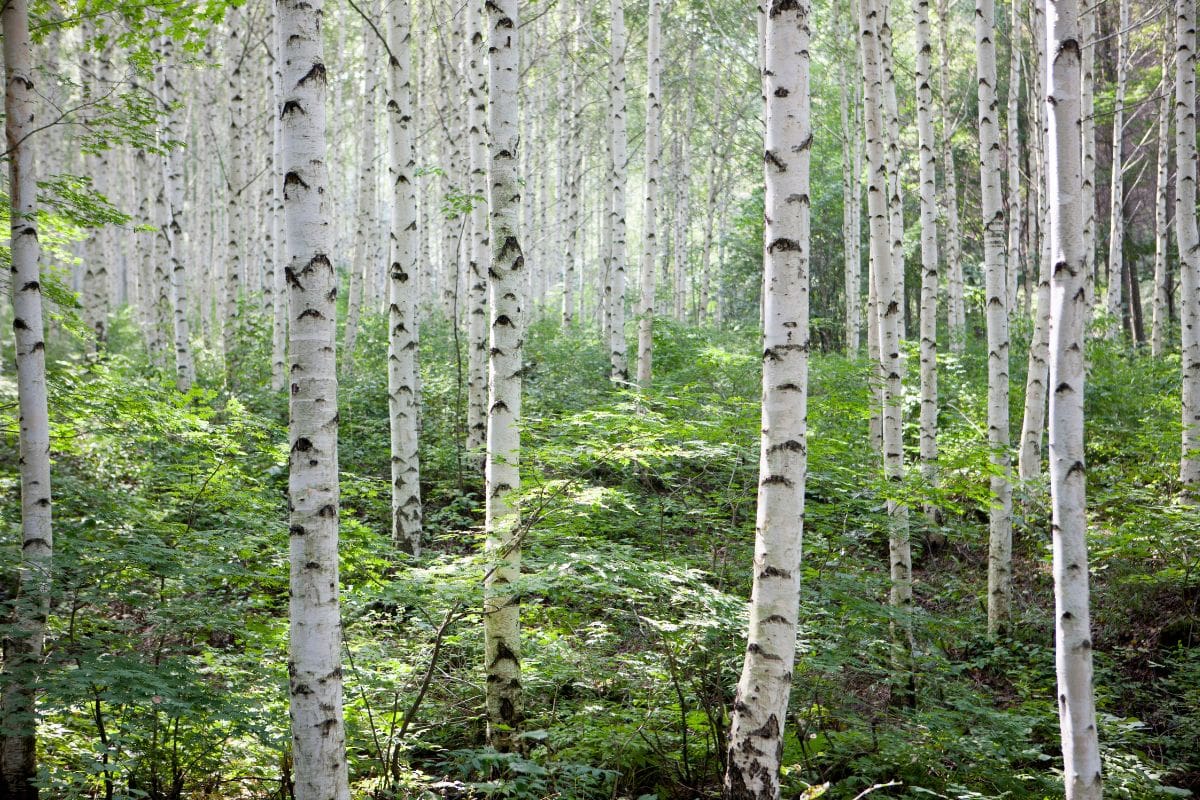
You could call the Paper Birch Montana’s unsung hero. Trust me, I’ve wandered through the northern temperate and boreal forests of North America where this native Montana tree reigns supreme alongside a smorgasbord of impeccable greenery.
- Native Status – The Paper Birch stands proudly as a native tree species in Montana, finding its place amidst the northern temperate and boreal forests of North America.
- Size – Despite its humble stature, the Paper Birch commands attention with its elegant presence, typically reaching heights of up to 15 meters (49 feet), making it a small to medium-sized tree in the landscape.
- Habitat Preferences – Thriving in moist sites within open woods, the Paper Birch finds its ideal habitat in the subalpine forests of the northwestern Montana Rocky Mountains, where it adds its distinctive charm to the verdant surroundings.
- Characteristics – Easily distinguished by its striking white, papery bark that peels in thin sheets, the Paper Birch earns its name from this unique feature. Its leaves, sharply pointed with doubly toothed margins, further contribute to its recognizable appearance.
- Reproduction – Unlike their coniferous counterparts, Paper Birches do not produce cones. Instead, they rely on other methods of reproduction to propagate and thrive in their habitat.
- Uses – Its wood serves as a valuable resource for various industries, including lumber, plywood, and paper pulp production. Its ornamental beauty makes it a sought-after tree for landscaping purposes. Its sap is also a source of syrup production, adding to its multifaceted utility in Montana’s ecosystem and economy.
Later, as I crafted a wooden spoon from Paper Birch with a local artisan, it dawned on me the importance of this lesser-heralded native tree. So, next time you’re exploring the woods of Montana, keep a keen eye out. You never know what natural treasures you’ll discover.
14. Whitebark Pine (Pinus albicaulis)
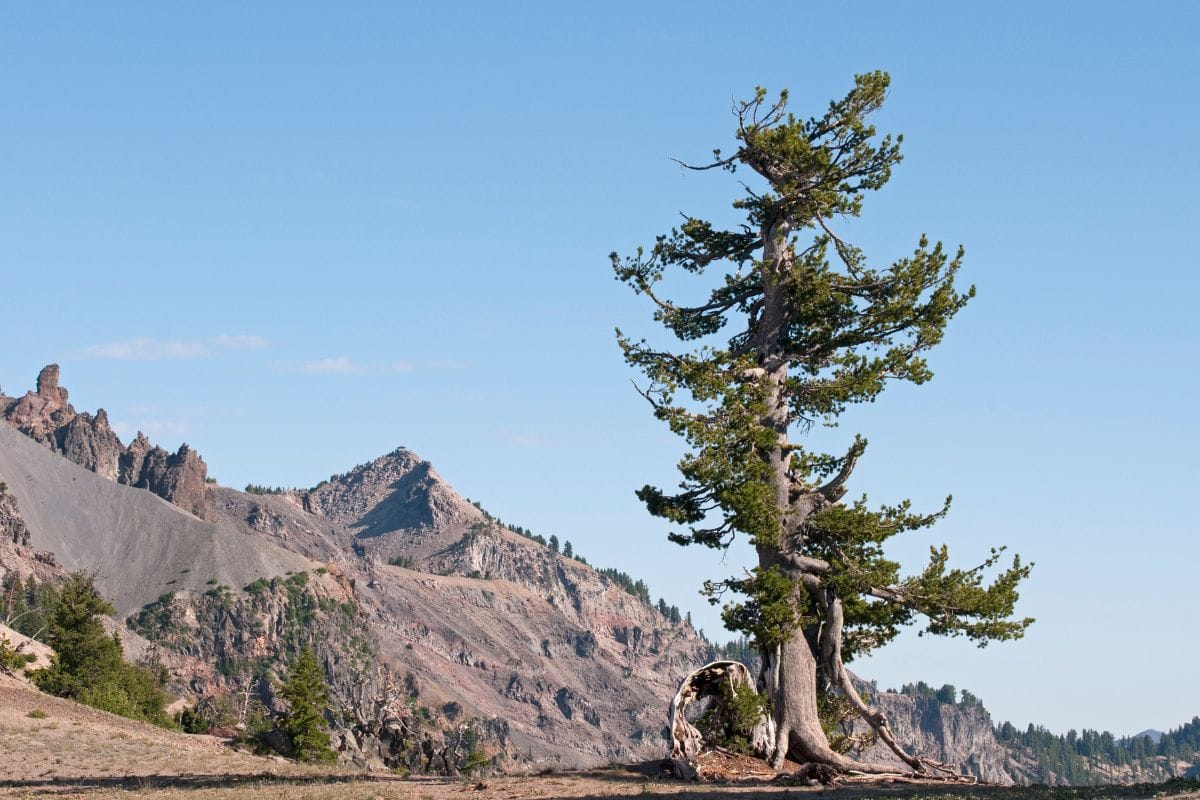
With roots deeply embedded in Montana’s soil, the Whitebark Pine proudly stands as a native tree species, its presence a defining feature of the subalpine ecosystems that adorn the northwestern Rocky Mountains.
A testament to endurance, the Whitebark Pine is a slow-growing, long-lived tree, typically reaching heights of 15-25 meters (49-82 feet), with towering individuals stretching up to 30 meters (98 feet) into the sky.
The Whitebark Pine thrives in rocky, windswept landscapes, often perched at or near the tree line, where it plays an indispensable role in shaping the ecology of these harsh environments.
With its broad, irregular crown and distinctive, white to grayish bark that weathers to a darker, more furrowed texture over time, the Whitebark Pine leaves an indelible mark on the landscape, both visually and ecologically.
The Whitebark Pine produces large, nutritious seeds encased within its cones, serving as a vital food source for a diverse array of wildlife, including the resourceful Clark’s nutcrackers, industrious red squirrels, and majestic grizzly bears.
Despite its formidable stature, the Whitebark Pine faces formidable challenges, including the relentless onslaught of white pine blister rust and mountain pine beetle epidemics, leading to a decline in both its population and range. Yet, like a beacon of hope, it stands resilient, a symbol of strength in the face of adversity.
As a keystone species in its ecosystem, the Whitebark Pine holds sway over the delicate balance of nature, enhancing biodiversity and providing invaluable ecological services such as soil stabilization and water regulation.
15. Rocky Mountain Maple (Acer glabrum)
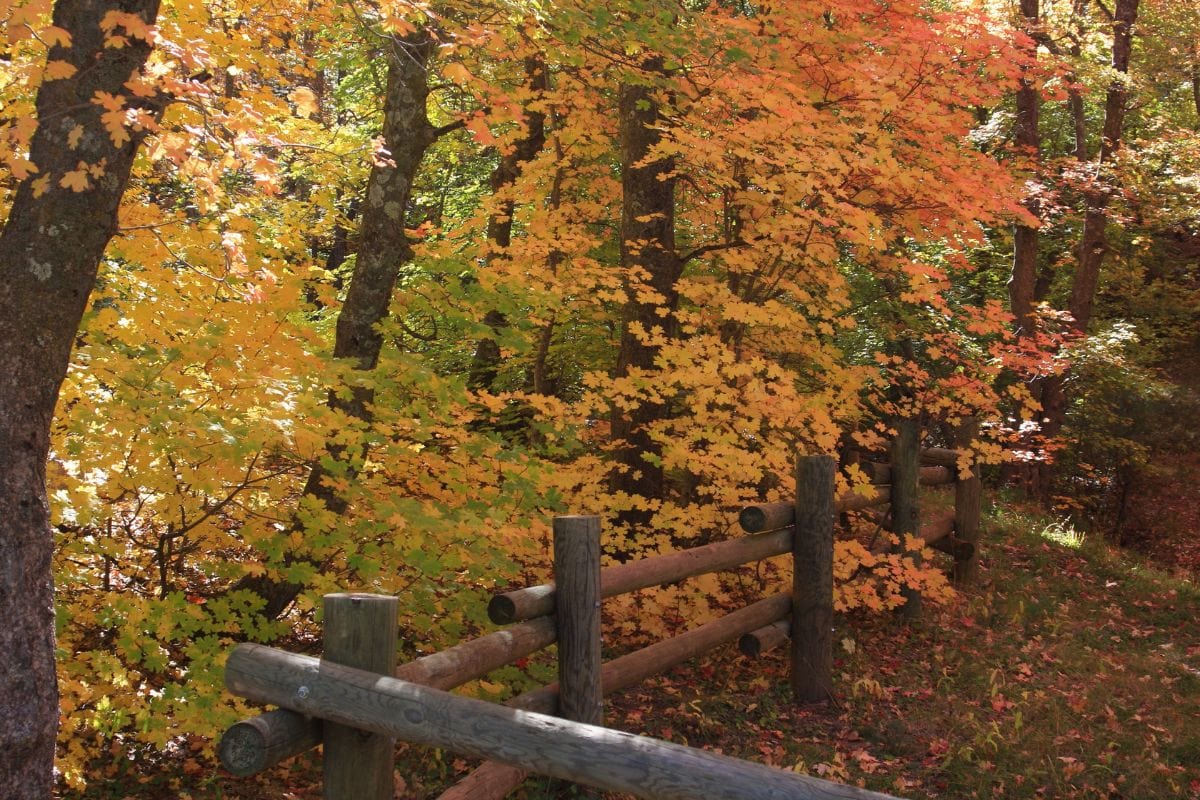
Native to the Montana mountains and the northwestern Rocky Mountains’ subalpine ecosystems, the Rocky Mountain Maple (Acer glabrum) is a plant parent’s dream.
The Rocky Mountain Maple is native to Montana, thriving in the subalpine ecosystems of the northwestern Rocky Mountains. Growing up to 15 meters tall, it often appears as a large shrub or a small tree in shaded areas among coniferous stands like Douglas fir and subalpine fir.
Identified by its ovate-cordate, glabrous leaves, and striking red bark, the Rocky Mountain Maple adds aesthetic value to the landscape, particularly during fall when its foliage turns red.
Apart from its visual appeal, the Rocky Mountain Maple serves as a vital food source for wildlife, making it a high-value browse species for big game. Its limited cultivation aids in habitat improvement and landscaping efforts.
It is found across the western United States, from Alaska and British Columbia to California, and extending to Montana and Nebraska, the Rocky Mountain Maple’s presence enriches diverse landscapes.
With its ecological resilience and ornamental beauty, the Rocky Mountain Maple contributes significantly to Montana’s ecosystem, enhancing biodiversity and adding aesthetic charm to the wilderness.
16. Quaking Aspen (Populus tremuloides)
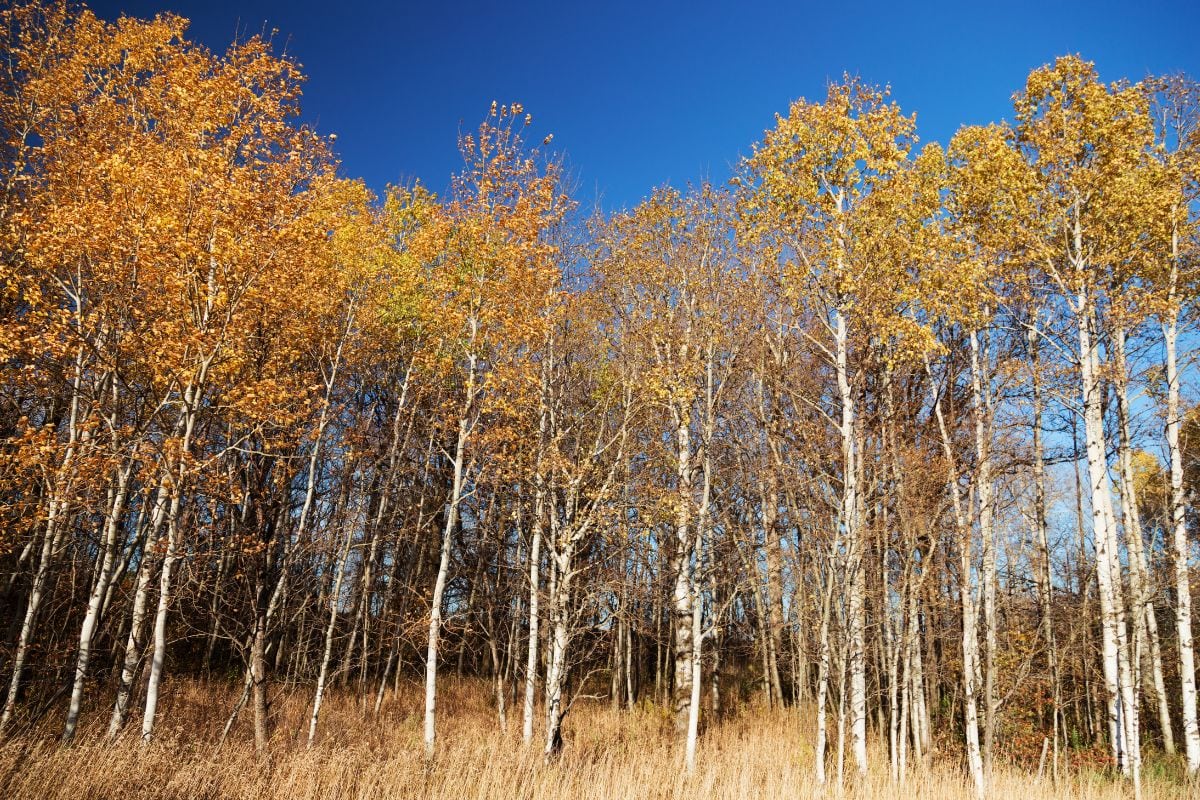
The Quaking Aspen is a medium-sized stature, smooth greenish-white bark, and trembling leaves make it instantly recognizable. You’ll often spot it in ravines and valley bottoms, cradled by the warm sunlight it adores.
- Native Status – The Quaking Aspen stands proudly as a native deciduous tree in Montana, renowned for its unique characteristics and ecological significance.
- Size and Habitat – With a medium-sized stature, Quaking Aspen thrives in Montana’s diverse landscapes, from foothills to subalpine zones, favoring sun-drenched areas like ravines and valley bottoms. Its slender trunks adorned with smooth, greenish-white bark add to its distinctiveness.
- Reproduction and Ecology – Often forming expansive stands called clones, Quaking Aspen reproduces primarily through root sprouts, boasting an interconnected root system that some ecologists argue makes it the largest living organism on Earth.
- Wildlife and Biodiversity – Aspen groves serve as keystone species, attracting a plethora of wildlife, including birds, insects, and mammals. These groves foster highly biodiverse forest ecosystems, especially along streamsides, enriching Montana’s natural heritage.
- Challenges and Decline – Despite their ecological importance, Montana has witnessed a concerning decline, losing an estimated 64% of its aspen groves. Factors such as fire suppression and overgrazing have contributed to this decline, underscoring the need for conservation efforts to preserve this iconic species and its invaluable role in the state’s ecosystem.
So, next time you’re admiring the golden hues of fall or the shimmering summer greens of our state, take a moment to appreciate this nature connoisseur’s darling, the Quaking Aspen.
17. Mountain Hemlock (Tsuga mertensiana)
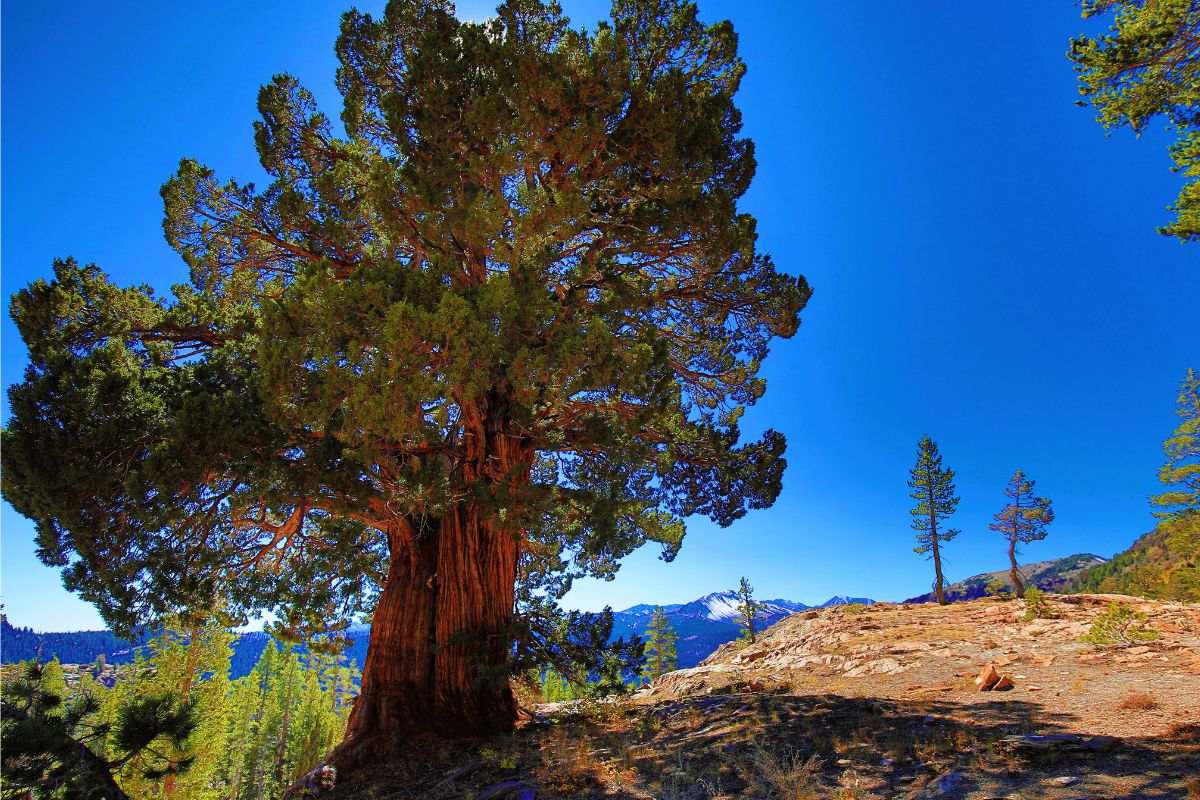
The Mountain Hemlock stands as a proud native coniferous tree in the towering mountains of Montana, adding to the rich tapestry of the region’s flora.
With its small to medium-sized stature, the Mountain Hemlock reaches heights of up to 45 meters, boasting a narrow crown with a slightly drooping leader. Its bark, ranging from grey to reddish-brown and deeply fissured, adds to its distinguished appearance.
Peripheral and sporadically distributed, the Mountain Hemlock occupies less than 5% of Montana’s landscape, primarily in the Rockies of northern Idaho and Montana, enriching these rugged terrains.
Distinguished by its slightly drooping leader, needles of equal length arranged radially around twigs, and larger cones measuring 1-5 inches (2.5-12.5 cm), the Mountain Hemlock stands apart from its Western Hemlock counterpart.
Thriving despite slow growth in its native habitat, Mountain Hemlocks adapt to long winters. While subalpine dwarfs may only reach 10 feet (3m), the tallest specimens soar to over 175 feet (50m). Some individuals exhibit remarkable longevity, with ages surpassing 500 years and possibly even reaching over 1000 years.
Endemic to the coastal regions of southeastern Alaska and British Columbia, Mountain Hemlocks find sanctuary in the mountains of Washington, Oregon, and California, as well as in the northern Rockies of Idaho and Montana, where they contribute to the unique biodiversity of these mountainous landscapes.
Types of Montana Trees Final Thoughts
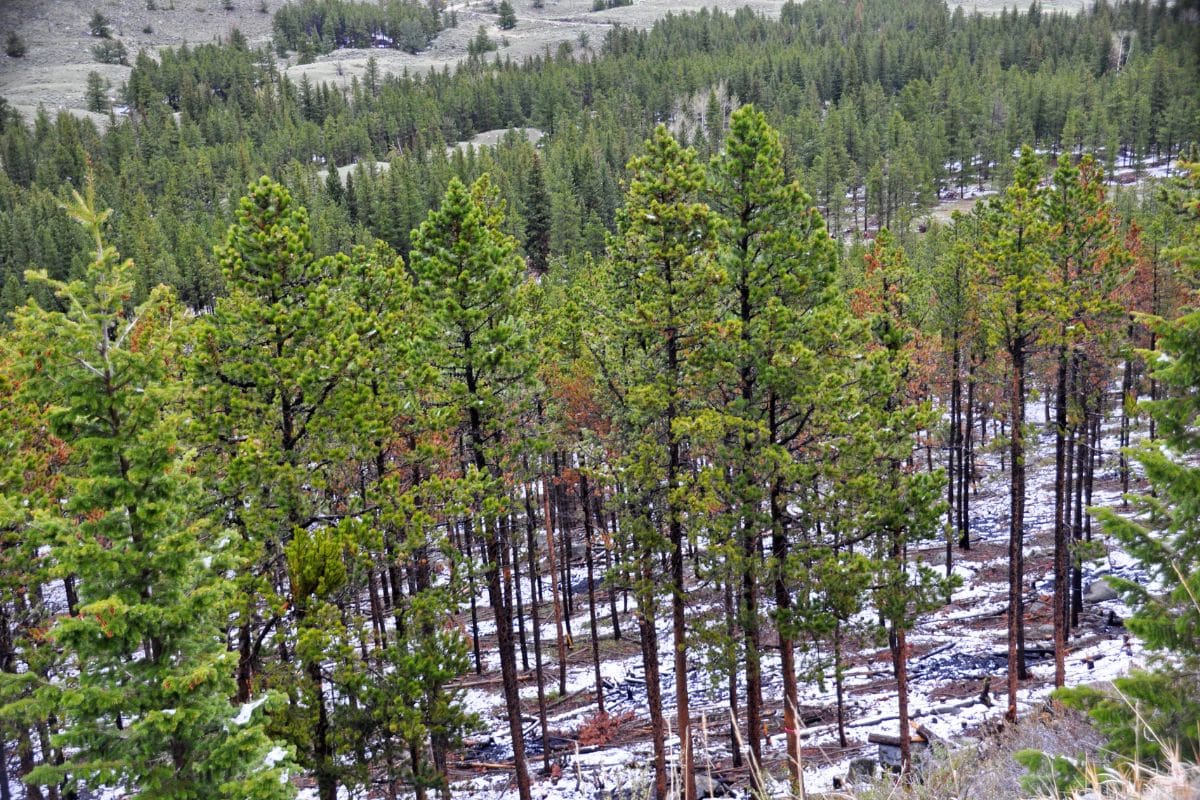
Montana’s diverse native tree species weave a captivating narrative, showcasing the state’s ecological vitality and cultural heritage. The commanding presence of the Ponderosa Pine, Montana’s official state tree, highlights its significance in the state’s arboreal wonders.
Unique characteristics and roles of Lodgepole Pine, Douglas-fir, Western Larch, and Rocky Mountain Juniper sustain Montana’s ecosystems. The hardiness of the Subalpine Fir, the resilience of the Limber Pine, and the majestic stature of Engelmann Spruce in the subalpine realms are essential.
The grandeur brought by the Grand Fir to Montana’s landscapes is undeniable. The endurance and ecological importance of White Spruce, Paper Birch, and Whitebark Pine in high-altitude territories are remarkable.
The vibrant understory contributions of Rocky Mountain Maple provide sustenance for wildlife, and the iconic nature of Quaking Aspen forms expansive groves that foster biodiversity.
The sporadic yet enduring presence of the Mountain Hemlock in Montana’s mountainous regions reflects the state’s commitment to preserving its natural heritage, where ecological resilience and aesthetic beauty converge in the diverse and thriving forests that define the state’s landscapes. These 17 native trees collectively illustrate Montana’s dedication to preservation.
Types of Montana Trees FAQs
1. What Is the Most Common Tree in Montana?
The Ponderosa Pine (Pinus ponderosa) holds the distinction of being the most common tree in Montana. Recognized for its commanding presence, distinctive bark, and prevalence in the state’s warm and dry forests, the Ponderosa Pine is not only iconic but also a key contributor to Montana’s diverse ecosystems.
2. What Kind of Spruce Trees Are in Montana?
Montana is home to several species of spruce trees, with the most notable being the Engelmann Spruce (Picea engelmannii). This native spruce is commonly found in subalpine forests of the northwestern Rocky Mountains.
Other spruce species in Montana include the White Spruce (Picea glauca), contributing to the state’s diverse coniferous landscape.
3. What Are the Biggest Trees in Montana?
Among the largest trees in Montana are the Ponderosa Pine (Pinus ponderosa) and Douglas-fir (Pseudotsuga menziesii). These towering conifers can reach impressive heights, with some individuals of both species exceeding 200 feet, contributing to the state’s majestic and expansive forested landscapes.
4. What Are the Fastest Growing Trees in Montana?
Cottonwood trees (Populus deltoides) are among the fastest-growing trees in Montana, flourishing along riverbanks and in moist areas. Additionally, the Silver Maple (Acer saccharinum) is known for its rapid growth and adaptability to various soil conditions, making it another swiftly developing tree in the state.
If this article piqued your interest, check out these other enthralling reads on Montana:
- https://www.umt.edu/native-garden/plant-index/native-trees.php
- https://fieldguide.mt.gov/displaySpecies.aspx?family=Pinaceae
- https://www.montana.edu/extension/gallatin/documents/naturalresourcesdocuments/2B0323.pdf
- https://www.flickr.com/photos/auvet/3752953945
- https://www.flickr.com/photos/plant_diversity/50040811833
- https://www.flickr.com/photos/plant_diversity/34813296946
- https://www.flickr.com/photos/plant_diversity/3289593124
- https://www.flickr.com/photos/bryanto/2801013137
- https://www.flickr.com/photos/plant_diversity/36766046563
- https://www.flickr.com/photos/stuartwildlife/5094407923
- https://www.flickr.com/photos/jsjgeology/52516028316

